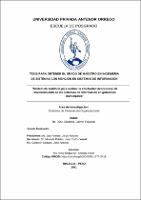| dc.contributor.advisor | Vidal Melgarejo, Zoraida Yanet | |
| dc.contributor.author | Díaz Sánchez, Jaime Eduardo | |
| dc.creator | Díaz Sánchez, Jaime Eduardo | |
| dc.date.accessioned | 2021-10-27T14:46:23Z | |
| dc.date.available | 2021-10-27T14:46:23Z | |
| dc.date.issued | 2021 | |
| dc.identifier.uri | https://hdl.handle.net/20.500.12759/8170 | |
| dc.description.abstract | Cuando se realizan auditorías a entidades, organismos y empresas del estado
peruano, los auditores se encuentran con diversas formas de gestionar los sistemas
de información. En muchas ocasiones, por el tamaño de la organización no se
cuenta con una oficina encargada de esa gestión, encargándose las funciones a un
usuario del sistema. También, se hace más frecuente la adquisición de sistemas de
información, que luego de su entrega se genera un descontrol en su proceso de
mantenimiento: no se realiza el seguimiento al mantenimiento, se accede
remotamente a los servidores, no se prueba la implementación de los
requerimientos o simplemente no es realizado. En esta realidad problemática, se
formula el problema de investigación ¿Cómo evaluar de la efectividad del proceso
de mantenimiento de sistemas de información en gobiernos municipalidades? y el
objetivo general “Describir la efectividad del proceso de mantenimiento de los
sistemas de información en gobiernos municipales mediante un modelo de
auditoría basado en las normas técnicas peruanas. El procedimiento aplicado
empieza con el análisis de las Normas Técnicas Peruanas 12207:2016 y 27001:2014
para identificar los procesos, actividades y controles relacionados al mantenimiento
de sistemas de información, luego se formulan las etapas del modelo son sus
respectivos procedimientos, correlacionando ambas normas técnicas; también, se
formulan los indicadores para evaluar la efectividad del proceso de mantenimiento,
con sus respectivas expresiones matemáticas de cálculo. Finalmente, el modelo
resultante ha sido sometido a la evaluación de un grupo de expertos auditores con
experiencias en auditoría gubernamental, para comprobar si es posible evaluar la
efectividad del proceso de mantenimiento. En este último paso, se elaboraron
preguntas con respuestas politómicas que fueron procesadas por el método de
coeficiente de Aiken, obteniéndose un valor de aprobación del 0.94 (94%). Los
resultados obtenidos permiten afirman que si es posible describir la efectividad de
un proceso de mantenimiento de sistemas información de un gobierno municipal
haciendo uso del modelo de auditoría propuesto | es_PE |
| dc.description.abstract | When audits are carried out on entities, organizations and companies of the
Peruvian state, the auditors find different ways of managing the information
systems. On many occasions, due to the size of the organization, there is no office
in charge of this management, the functions being entrusted to a user of the system.
Also, the acquisition of information systems becomes more frequent, which after
their delivery generates a lack of control in their maintenance process: maintenance
is not monitored, the servers are accessed remotely, the implementation of the
requirements or it is simply not done. In this problematic reality, the research
problem is formulated: How to evaluate the effectiveness of the information
systems maintenance process in municipal governments? and the general objective
“Describe the effectiveness of the maintenance process of information systems in
municipal governments through an audit model based on Peruvian technical
standards. The applied procedure begins with the analysis of the Peruvian Technical
Standards 12207: 2016 and 27001: 2014 to identify the processes, activities and
controls related to the maintenance of information systems, then the stages of the
model are formulated with their respective procedures, correlating both standards
techniques; Also, the indicators are formulated to evaluate the effectiveness of the
maintenance process, with their respective mathematical expressions of calculation.
Finally, the resulting model has been submitted to the evaluation of a group of
expert auditors with experiences in government auditing, to check whether it is
possible to evaluate the effectiveness of the maintenance process. In this last step,
questions with polytomous responses were elaborated that were processed by the
Aiken coefficient method, obtaining a passing value of 0.94 (94%). The results
obtained allow us to affirm that it is possible to describe the effectiveness of a
municipal government information systems maintenance process using the
proposed audit model. | en_US |
| dc.description.uri | Tesis | es_PE |
| dc.format | application/pdf | es_PE |
| dc.language.iso | spa | es_PE |
| dc.publisher | Universidad Privada Antenor Orrego | es_PE |
| dc.relation.ispartofseries | M_INGE_146 | |
| dc.rights | info:eu-repo/semantics/closedAccess | es_PE |
| dc.rights.uri | https://creativecommons.org/licenses/by/4.0/ | es_PE |
| dc.source | Universidad Privada Antenor Orrego | es_PE |
| dc.source | Repositorio Institucional - UPAO | es_PE |
| dc.subject | Mantenimiento | es_PE |
| dc.subject | Modelo | es_PE |
| dc.title | Modelo de auditoría para evaluar la efectividad del proceso de mantenimiento de los sistemas de información en gobiernos municipales | es_PE |
| dc.type | info:eu-repo/semantics/masterThesis | es_PE |
| thesis.degree.level | Maestría | es_PE |
| thesis.degree.grantor | Universidad Privada Antenor Orrego. Escuela de Postgrado | es_PE |
| thesis.degree.name | Maestro en Ingeniería de Sistemas con Mención en Sistemas de Información | es_PE |
| thesis.degree.discipline | Maestría en Ingeniería | es_PE |
| dc.subject.ocde | https://purl.org/pe-repo/ocde/ford#2.02.04 | es_PE |
| renati.advisor.orcid | https://orcid.org/0000-0002-1777-3419 | es_PE |
| renati.author.dni | 19210676 | |
| renati.advisor.dni | 18153095 | |
| renati.type | https://purl.org/pe-repo/renati/type#tesis | es_PE |
| renati.level | https://purl.org/pe-repo/renati/level#doctor | es_PE |
| renati.discipline | 612997 | es_PE |
| renati.juror | Jara Arenas, Jorge Antonio | |
| renati.juror | Miranda Robles, Juan Carlos | |
| renati.juror | Calderón Sedano, José Antonio | |
| dc.publisher.country | PE | es_PE |


